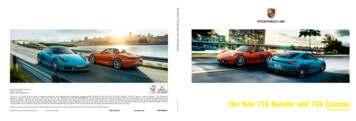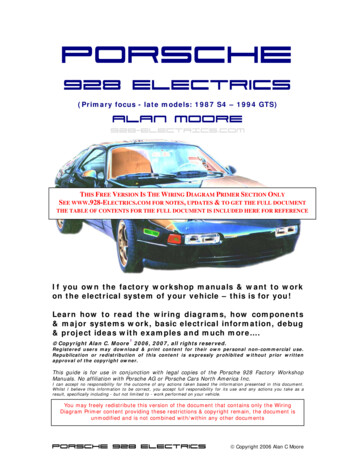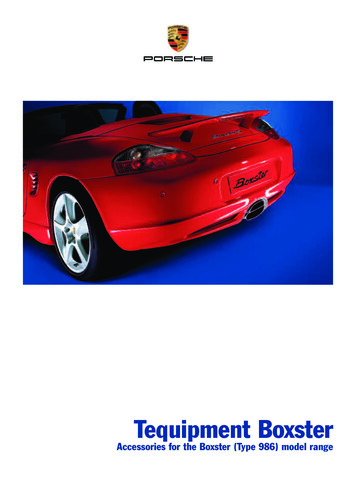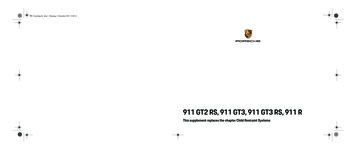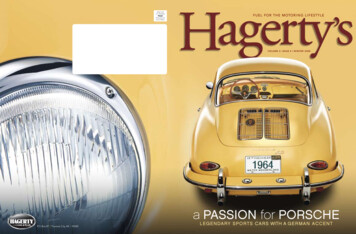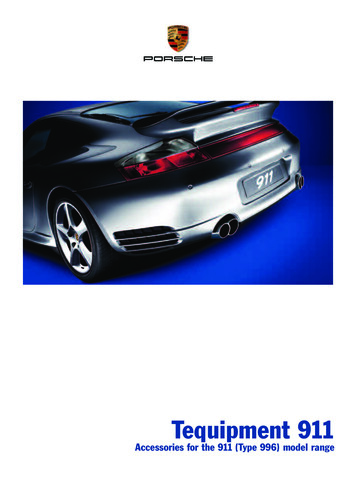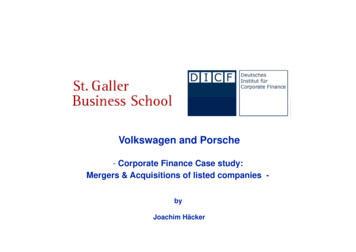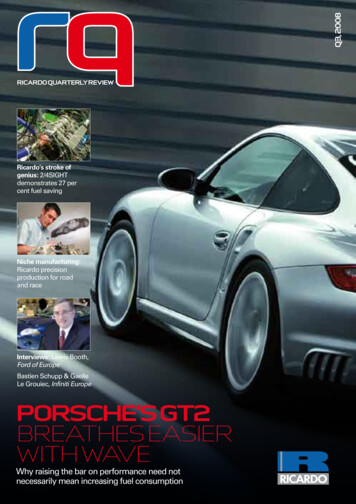
Transcription
Q3, 2008Ricardo Quarterly reviewRicardo’s stroke ofgenius: 2/4SIGHTdemonstrates 27 percent fuel savingNiche manufacturing:Ricardo precisionproduction for roadand raceInterviews: Lewis Booth,Ford of EuropeBastien Schupp & GaelleLe Grouiec, Infiniti EuropePorsche’s GT2breathes easierwith WAVEWhy raising the bar on performance need notnecessarily mean increasing fuel consumption
ALTERNATIVE THINKING ABOUT COMPUTER MODELING AND SIMULATIONTo achieve precise simulations,sharpen your tools.Alternative thinking is realizing that advanced simulations are impossiblewithout advanced tools. HP’s groundbreaking c-Class BladeSystem combinedwith Ricardo’s automated mesh generation software delivers razor-sharptechnology for rapid turn-around of CFD analyses.HP BladeSystem EnclosuresFrom project conception to project completion, HP experts and industryleading partners help you sharpen your computing tools to achieve higheraccuracy simulations and reduced design times. Simple to manage, easy to control: Integratesserver, storage, networking, and powermanagement into a single solutionTechnology for better business outcomes.To learn more, visitwww.hp.com/go/optimize-caewww.ricardo.com 2008 Hewlett-Packard Development Company Entry Level standalone Blade c3000 Enclosurethat plugs into standard wall socket—no datacenter required Easy on your budget: Reduce up-front capitalcosts and ongoing management costs with HPThermal Logic Technology
ContentsRicardo Quarterly Review Q3, 2008082415news04 Industry newsElectric cars approach production reality; Porsche’s first dualclutch transmission; Honda solves super-sports bike ABSdilemma; Mazda maps out future fuel-saving strategy24 Ricardo newsNew upgrade for WMIK; eAMT demonstrates next-generationtransmission technology; low carbon vehicle initiativesannounced and new advisory board for RSCfeatures08 Switching cyclesCO2 savings of 27 per cent are promised as Ricardo’sremarkable 2/4SIGHT engine switches between two- andfour-stroke operation. Anthony Smith lifts the lid on a keynew technology15 Porsche profits from WAVEquestions and answersThe Stuttgart sportscar maker’s iconic 911 GT2 gains yetmore power and torque, but with no increase in consumption.Porsche’s Dr-Ing L Theilemann explains how it was done usingRicardo’s WAVE software06 Infiniti Europe21 Made to measureDoes Europe need another premium brand? Tony Lewinquestions the Nissan prestige marque’s top marketingexecutives Bastien Schupp and Gaelle le Grouiec18 FordRicardo is best known for its R&D, but it also manufacturespowertrain products in its own right. As Anthony Smithreports, these range from prototype parts to seriescomponents for road and racetrackLewis Booth has overseen a dramatic turnaround in Ford’sEuropean business. Tony Lewin asks him about CO2, Volvo,Jaguar, and the prospects for Ford’s global operationsHead office:Ricardo plc, Shoreham-by-Sea,West Sussex, BN43 5FG,United KingdomTel: 44 (0)1273 455611Ricardo contacts and locations:www.ricardo.com/contactsRQ subscriptions: www.ricardo.com/rqSales enquiries: business.development@ricardo.comConceived and produced for Ricardo by:TwoTone Media LtdEditor: Tony LewinContributors:Mark Roberts, Anthony Smith,Dr-Ing L TheilemannTwoTone Media Ltd contacts:Anthony Smith: AVSmith@2tmedia.comTony Lewin: tonylewin@2tmedia.com
Industry NewsNissan’s battery-powered Denki cube willbe used in a 2010 field trial in the USElectric carspoisedfor productionrealityHNews in briefalf of all drivers would be interestedin buying an electric car for urbantraffic, while more than one in threewould choose a hybrid, with two thirdsof all motorists majoring on shortjourneys. The survey of 8000 motoristsin eight countries, conducted by leadingsupplier Continental Automotive,reveals a decisive shift in buyer opinionin the wake of rising fuel prices andgrowing environmental concern.The results come amid a flurryof announcements from leadingautomakers and suppliers about batteryand electric vehicle programmes,prompting analysts for the first time topredict significant future market sharesfor battery-powered models.Renault-Nissan, which has vowedto make itself world leader in zeroemission vehicles, and which hasrecently announced EV partnershipsin Israel and Denmark for 2011, hasnow added Portugal to its list of EVschemes. The lithium-ion Kangoowill have a range of 160 km and theperformance of a 1.6 litre combustionengined equivalent. Battery partnerNEC is gearing up for an initial volumeof 13,000 units a year, with US andJapanese deliveries beginning in 2010.Daimler has committed its Smartmicrocar brand to the 2010 launch ofan electric ForTwo, and will be first tomarket with Continental-JCI suppliedlithium-ion batteries in a hybrid S-Classearly next year. BMW has confirmed itis working on an electric Mini, initiallyfor California.PSA Peugeot Citroën has teamed upwith Mitsubishi and battery maker GSYuasa for an electric small car withintwo years, and Volkswagen (workingwith Sanyo) and GM Chevrolet promise2011 and 2010 for their Up minicarand Volt model respectively. Toyota’sVGT turbo will withstand EGRBorgWarner has developed anew compressor wheel coatingto allow variable geometryturbochargers to withstand theharsh environment created by theexhaust gas recirculation neededfor low NOx emissions.alliance is with Panasonic Matsushita,which has said it will build two newbattery factories for the purpose.GM has yet to confirm a batterysupplier for the Volt – both Continentaland Compact Power LG have beenawarded development contracts – andwhile Bosch, Samsung and MagnaSteyr have all revealed lithium-ionPorsche’s firstdouble clutchPorsche, which pioneered thePDK double clutch transmissionin endurance racing two decadesago, has finally released its firstroadgoing DCT, on a new versionof its iconic 911 Carrera sports car.Replacing the previous Tiptronic Sautomatic, the seven-speed PDKtransmission has twin multiplate wet clutchesand offers a variety of manual modes as well aslaunch control and fully automatic operation.Diesel better than hybridCurrent hybrids offer nosignificant CO2 savings over anequivalent diesel, says websitecleangreencars.co.uk. Threehybrids – a Prius, a Lexus GSand a Honda Civic – were eachmatched or beaten by diesels.4 RICARDO QUARTERLY REVIEW Q3, 2008battery programmes, no automakerpartnerships have yet been announcedIn California, Fisker Automotive hassaid it is still on track for late-2009deliveries of its Karma plug-in hybridelectric luxury sedan, and Tesla hasbegun exports to Europe of its Lotusbased high-performance two-seaterbattery-powered roadster.Momentum isbuilding behindfuel cell hybridvehicles, too, withRenault showing ahydrogen-poweredScenic, Toyotadoubling the rangeof its fuel cellresearch vehicle to830 km, and Hondacommencing limitedproduction of itsFCX Clarity sedan.Hybrid module productionGerman transmissions specialistZF will shortly begin manufactureof hybrid modules destined fora variety of European models.The company expects to rampup production of the units –whichspan the 10 to 100 kW range.Diesel share may have peakedThe diesel boom in Germany ispast its peak, says a study by theCenter for Automotive Research.Rising diesel costs and improvinggasoline engines will causediesel’s share to fall from today’s48 per cent to 30 per cent in 2020.
Brake by wirefor super-sports bikesRicardoQuarterlyReviewConventionalantilock brakeshave been hard toimplement on supersports motorcyclesbecause of theirshort wheelbaseand tendency topitch under heavybraking. Now Hondahas taken advantageof the low mass andhigh controllability of brake-by-wiresystems to offer linked front-rearABS braking for top performancemotorcycles.The new combined braking systemhas direct motor control of the twinfront and single rear brakes, advancedelectronics being able to measurethe rider’s pressure on the handlebarbrake lever and foot pedal to achievethe optimum balance between brakingforces on the front and rear wheels.As well as preventing wheel lock,Hand LeverHonda claims the combined brakesystem is also able to improve balanceand allow uninterrupted corneringand sports performance. A furtheradvantage, says Honda, is that thesystem is divided into several smallunits, meaning that the mass can bemore easily concentrated at the centreof gravity of the bike.The new CBR 1000 Fireblade (above)is the type of super-sports bike that coulduse Honda’s new by-wire combinedbraking system.Foot LeverRear brakeValveUnitFront Brakesinput Line (Connect to M/C)ECUPowerUnitValveUnitPowerUnitoutput Line (Connect to C/C)connecting between modulesThe task of RQ is to highlight the latest thinkingin automotive engineering and technologyworldwide – both within Ricardo and amongother leading companies. By presentingan up-to-date mix of news, profiles andinterviews with top business leaders we paintan interesting and exciting picture of R&Dactivity at a world-class automotive engineeringservices provider.It is a formula that has certainly been a hit withthe worldwide automotive community: in theseven years since RQ was launched we havehad to increase our print run to 14,000 copiesto keep pace with the demand to read aboutRicardo and its activities.Client confidentiality is of the utmostimportance to Ricardo, which means thatwe can only report on a small fraction of thework carried out by the company. So we areespecially grateful to those Ricardo customerswho have kindly agreed to co-operate with RQand allow their programmes to be highlightedin print: without such help from customersit would not be possible to present such afascinating insight into the way vehicles areconceived and developed.Engines of the yearBMW scooped six out of the dozen 2008Engine of the Year awards, decided byan international panel of journalists andtechnical experts. As well as having arepeat overall winner in the shape of the3.0 litre twin-turbo gasoline six, BMW alsotook the 3.0, 4.0 and over 4.0 litre awards aswell as clinching the 1.4 to 1.8 litre prize withits 1.6 litre Mini turbo unit, produced jointlywith PSA.In addition, the German company’s 2.0litre twin turbo diesel was named best newengine; Toyota’s Prius hybrid was againdeclared best green engine.Control UnitMazda’sFrontfuelValve Unitsaving planMazda is targeting a 30 per cent cut in itsvehicle range fuel consumption by 2015using a combination of weight reduction, anall-new line-up of engines and a novel SmartIdle stop-start system.Smart Idle is unique in that it does notuse an electric motor to restart the engine,Frontinstead injecting fuel into the cylinder andPulserigniting it to force the pistonFrontdown.Speed FuelSensorRingsavings of 7-8 per cent are claimed.Opel electric car “ 10,000 more”GM Europe’s first electric car willuse Chevrolet Volt architectureand cost 10,000 more than aconventional model, says GMEurope president Carl-PeterForster in an interview withAutomobilwoche.New diesel engines launching in 2011 willRear Power Unituse next-generationinjection and boostingtechnology to achieve 20 per cent bettereconomy, while the 16X rotary enginewill for the first time incorporatedirect gasoline injection and,says Mazda, high-speedRear Pulser Ringcombustion technology.Post-2011 reciprocatinggasoline engines willimprove both powerand economy by 20per cent,saystheFrontPowerUnitRear Speed Sensorcompany.After biofuels – bio plasticsDashboards and bumpers could bemade from bio plastics which donot detract from food production ifa Mazda project proves successful.The versatile polypropylene is madefrom cellulosic biomass convertedto ethanol.Federal rules expose anomaliesNew CAFE proposals for the2015 model year have thrown upawkward anomalies which tend topenalise European automakers, saysAutomotive News. By measuringvehicles not by weight but accordingto their footprint (track multipliedby wheelbase), the new systemdemands much bigger mpgimprovements from smaller cars.Under the rules, says AN, Mercedes’cars would have to get better mpg thanToyota’s. Worst affected is Porsche,which would have to reach a fleetaverage of 41.3 mpg to avoid fines.Q3, 2008 RICARDO QUARTERLY REVIEW 5
RQ Interview – Bastien Schupp and Gaelle le GrouiecBrand ambassadorsNissan’s premium brand Infiniti arrives in Europe in October,promising ‘total ownership experience’. Marketing directorBastien Schupp and customer services director Gaelle LeGrouiec tell Tony Lewin how this philosophy will help them stealsales from the established premium nameplatesIs there room for another premiumbrand in Europe?Bastien Schupp: Definitely. Accordingto our research there is room for a newbrand – our major competitors can beseen on every street corner, and we’vehad many customers say driving a carlike that is nothing special any more.There’s room for a differentiated offerfor someone who wants to express hispersonality more through a different car.Where does the service element come in?BS: On top of that we’ve discovered that[currently] you get either an exciting caror good service – it’s extremely difficultto get both. So that’s what we’re trying tooffer – performance with a human touch.We have high-performing cars with anorganic touch – very fluid lines, but linkedto a very individualised service.So what can Infiniti offer that otherpremium players can’t?Gaelle Le Grouiec: There’s a demandfor a much larger experience, not justconfined to the car. This is what makesInfiniti different from the others: wewill provide the experience of the car,with all the technology and the unique6 RICARDO QUARTERLY REVIEW Q2, 2008design we have shown, and also anexperience through the [Infiniti] centre,the retail environment.How is the retail environment differentfrom those of your competitors?GLG: We have developed a specificdesign for the centres that is basedon [the concept of] a lobby, loungeand gallery. This has been inspiredby luxury hotels and gives a veryspecific atmosphere – warm, elegantand completely aligned with luxurycodes. We’re pushing this conceptfurther by having a more engagingcommunication at the centre level,with dedicated customer-centrictechnologies – such as interactivescreens with car visualisers. We’reeven proposing a special Infiniti sounduniverse: we have created specificInfiniti sounds and you will hearthis music at the centres. This is [atechnique] developed by another luxurybrand – a non-automotive one.How will Infiniti’s service offering differfrom what’s already there?GLG: With service it’s the same spirit –meeting customer needs, with servicescompletely tailored to our customerlifestyle. An illustration of this is whatwe call individual mobility assistance,and the key word here is individual.If you car breaks down – we need tocater for everything – you will decidethe kind of mobility you want, whetherit’s a chauffeur-driven car, a five-starhotel or a business class ticket. Moreimportantly, if you are travelling withsomeone else, even if they don’t havean Infiniti car, you will still be covered iftheir car breaks down.BS: You’re definitely buying more thanjust the car. You’re buying into what wecall the Total Ownership Experience,which goes far beyond the car.GLG: We’re an inclusive brandaddressing exclusive customers, andthis is what is unique today in Europe.Why does Renault-Nissan need Infinitiin Europe? Does it give access to highermargins, for instance?BS: The reason why we’re launchingnow is this. The brand was born fromJapanese parents in the US; it wasraised in the US and travelled across theworld; the product range is now readyfor the more demanding Europeancustomer; the organisation is right, thearrival of a powerful diesel engine inthe group – these are all reasons whywe believe Infiniti is ready to attack themost demanding premium market inthe world.Where does the dissatisfaction withother premium brands lie?GLG: Again, it’s on the experience side.
Either you get great product but noservice, no experience, or vice versa.We also do a lot of benchmarking ofthe evolution of luxury in Europe. Ithas changed completely over the lastten years: ten years ago it was veryshow-off, expressing your social status.Today it’s much more individualised. Byproposing the kind of car we have, witha unique combination of performance,comfort and design, plus the expansionof this experience through the retailenvironment, we are completely in linewith this new luxury cult.What are the other luxury brandsdoing wrong?BS: What we hear from many customersis that they’re very excited about the car,but that for that amount of money theywould expect to be treated differently,that they’re more important than that.There’s a lack in the market there.If Infiniti were a fashion brand, whichlabel would it be closest to?BS: When you by a car like an Infiniti,you’re taking a calculated risk. Yourneighbour will probably not knowwhat you’re driving – that’s part of therisk, but also part of the excitement ofbeing able to explain something thathe doesn’t know. So we’re looking atcustomers who want a differentiatedoffer, who don’t want to compromisebetween an exciting product and a veryindividualised service. We’re talkingto people who, rather than wantingto impress, want to be recognised bythose who are in the know. So veryoften we liken Paul Smith as a brandthat on the outside is relatively classicalbut on the inside is quite surprising:when you’re in the know, you recognisepeople who are wearing Paul Smith.You don’t show off with Paul Smith:instead, it’s an “Oh, I know.”GLG: Again, it’s an inclusive brandposition – this is why we give thetotal ownership experience, a globalapproach. This is what’s missing todayin the market, and this is what Infinitiwill bring.BS: We’d prefer to make a bigimpression on a few people rather than asmall impression on a huge crowd.GLG: We’re not a volume premiumbrand: the challenge for us is to beperceived and acknowledged as apremium luxury brand, but not a volumeone. You can drive between Geneva andLausanne in one of our competitors’ carsand see ten other cars exactly the same.This is not what we want.Is engineering advancement animportant asset of your cars? Can youafford to invest as much in technologyas your German competitors?BS: Definitely. One of the important“Often we liken Infiniti to Paul Smith as abrand that on the outside is relatively classicalbut on the inside is quite surprising: whenyou’re in the know, you recognise people whoare wearing Paul Smith”things when you enter the premiumsegment is to have technologicalcredibility. If you look at our four cars– the G sedan, the G coupé, the EXcoupé-crossover and the new FX – theyall come fitted with V6, 3.7 litre engines;the FX has a five-litre V8 engine. We’vegot very distinct technologies in thesecars, centred around the customer.Some of them are performanceoriented, like the four wheel active steer,a world premiere on a RWD car; othersare more comfort-oriented, like the allround view monitor.Are these technical qualities decidingfactors for customers, or will it be theservice?GLG: It’s both.BS: We can compete with the Germanbrands on technology. We have worldclass handling, world-class driving.We’re a driving brand. I’m one of the fewprivileged people to have driven all four ofour models at over 200 km/h on Germanautobahns, and after 10 years experienceat Audi I can guarantee to you that ourcars can compete with German cars.Market feeling has swung sharplyagainst SUVs and heavy CO2 emitters,and you have only V6 and V8 engines,and no diesels. Aren’t you out of stepwith customers?BS: We will have a diesel engine, tofollow the V6 and V8 gasoline enginesabout 18 months after launch. Weand our customers are obviouslyconcerned about CO2, but it wasimportant in our strategy to positionthe brand as a performance brand rightfrom the start. You wouldn’t be able todo this with the smallest engine on themarket. We do believe there’s a marketout there for performance cars, forpeople who like driving.Infiniti, the premium brand of Nissan,started sales in 1989 through 51 dealersin the US. By the end of its first decadeit was selling 75,000 units annually andbegan tackling markets outside the USsuch as Taiwan, the Middle East, Korea,China, Ukraine and Russia. Today it sells150,000 units annually in 15 markets,and launches in Europe in October.Q2, 2008 RICARDO QUARTERLY REVIEW 7
2/4 SIGHTStroke ofgenius for gasolinedownsizingAgainst the backdrop of spiralling gasoline pumpprices, a revolutionary new engine conceptdeveloped by a consortium led by Ricardooffers an attractive alternative to conventionalspark ignited combustion. The 2/4SIGHT enginepresents the prospect of 27 per cent fuel savingscompared with current engine technology bycombining the benefits of two- and four-strokecombustion, as Anthony Smith reportsESource: US Government Energy Information Administrationngine downsizing has long beenacknowledged as an importantroute to the improvement of fueleconomy. All else being equal, a smallerengine has less internal friction so thatless energy is wasted merely in turningits internal components. It also hasless thermal inertia, which means thatit warms up more quickly and is thusmore thermally efficient in a typicalmixed-duty, real-world operation.Moreover, as most car enginesoperate at well below their point ofpeak efficiency in day-to-day use, bysubstituting a smaller capacity unitoperating at higher specific load thecombustion and gas exchange processcan be more efficient.To deliver the same performance asa larger engine, however, a downsizedunit must employ charge air boostingeither in the form of turbocharging orsupercharging. While these measuresclearly give rise to some product costimplications, the resulting higher cycleefficiency and lower friction can offermuch sought-after fuel economy andCO2 emissions improvements.Nevertheless, there are also somevery practical limits to downsizing in aconventional four-stroke engine. Themain obstacle to downsizing is theachievement of good low-speed torqueand launch feel. The boost systemapplied to a downsized engine willproduce more torque, but this is limitedRetail price of gasoline – cents per US Gallon40035030025020015010050020002001200220038 RICARDO QUARTERLY REVIEW Q3, 200820042005200620072008With fuel prices on the increase(left) the 2/4SIGHT is an attractiveengine technology. The first researchprototype (main picture) was installedat the Sir Harry Ricardo laboratory ofthe University of Brighton.
“When we firstconceived the2/4SIGHT enginewe realised that wecould potentiallyovercome thecompression ratiobarrier to furtherdownsizing ”Professor Neville Jackson,Ricardo grouptechnology directorby the onset of abnormal combustionas higher pressures and temperaturesare reached; this is a problemparticularly pronounced at lowerengine speeds. High cylinder pressuresrequire larger connecting rod and crankbearings to accommodate the increasein load. This in turn can increase frictionsuch that the benefits of downsizingcan be significantly reduced. To operatesuccessfully, highly boosted four-strokeengines must therefore use a lowerstatic compression ratio, which thenreduces efficiency and negates thebenefits of any further downsizing.Launch feel can also be a challengefor turbocharged engines due to thefinite time required to accelerate theturbocharger from idle to generateboost pressures. Mechanically drivensuperchargers can help to resolve thisissue but these devices also increaselosses and reduce efficiency.Taking downsizing one step furtherHybridisation, in effect using electricpower to augment low-end torque, isa well proven route to enabling furtherlevels of downsizing. But while thisapproach works successfully in manyproducts, it brings significant additionalcost and complexity in the shape of thehybrid powertrain, power electronicsand energy management systems.An ideal solution to the twin obstaclesto aggressive downsizing – low speedtorque performance and high specificpower combustion stability – wouldbe a solution internal to the engineQ3, 2008 RICARDO QUARTERLY REVIEW 9
2/4 SIGHTand hence not requiring additionalsystems. This was a challenge whichhad occupied the engineers of Ricardo’stechnology group for some years.However, in 2004 Ricardo decided that acombustion system initially developedby the company in the late 1980s mightoffer a solution.Flagship technologyOver fifteen years ago Ricardo haddemonstrated a poppet-valve twostroke engine concept known asthe ‘Flagship’ engine; the conceptwas intended for premium vehicleapplications where a higher performingpremium vehicle two-stroke enginecould be used within the same basicarchitecture as a more basic four-strokeused for lower performance vehiclederivatives.The concept was demonstratedsuccessfully as both single and multicylinder demonstrator engines butresearch was curtailed when it becameclear that its commercial applicationwould be limited. Yet there wereaspects of the Flagship combustiontechnology which have since madetheir way into successful conventionalengines. The engine had achieved itsscavenging performance through theuse of a top entry intake port geometrywhich, combined with port shielding,created a reverse tumbling motion oninduction. This same Ricardo-patentedsystem has since found application ina number of direct injection gasolineengines where it is a well provenenabler of stratified combustion.Two into four does goIn something of a eureka moment,engineers in the Ricardo technologygroup realised that the intake andcombustion chamber geometryoriginally developed for Flagship couldbe used as the basis of an enginecapable of operating in either two- orfour-stroke modes. The new concept,named 2/4SIGHT, offered someimmediate and attractive benefitsfor the challenge of gasoline enginedownsizing.“When we first conceived the2/4SIGHT engine we realised thatwe could potentially overcome thecompression ratio barrier to furtherdownsizing,” explains Ricardo grouptechnology director, Professor NevilleJackson. “By running the engine intwo-stroke mode under low-speed/high-load conditions, the torqueproduced by each cylinder every powerstroke is about half of that which wouldneed to be produced by a four-strokeengine under the same duty. Thismeans that the engine can retain ahigh compression ratio and wouldnot require an increase in crank androd bearing sizes. This configurationcan deliver higher efficiencies than aboosted four-stroke engine with similartorque and power output. Two-strokeoperation effectively offers a meansof boosting low-end performance,in the process further increasing theopportunity for downsizing in sparkignition engines. The main benefitto the driver would be reduced fuelconsumption and, possibly, betterlaunch feel.”The 2/4SIGHT engine would start inexactly the same manner as a typicalfour-stroke direct injection gasolinecar engine. Its control system wouldmonitor driver demand and whenmore torque is required than wouldbe possible in four-stroke mode,the fuelling, air handling and valvetrain would be adjusted to enableswitching within a single cycle andon an individual cylinder basis so thattorque delivery remains smooth anduninterrupted as the engine switchesbetween modes. Only the engine notewould change due to the different firingfrequency, much as in the sound madeduring a transmission downshift.CAE concept simulation studyIn 2004 part funding was madeavailable under the UK government’sForesight Vehicle programme forRicardo and a consortium includingtwo leading UK Universities – Bruneland Brighton – as well as a numberof auto industry partners, to embarkHow the 2/4SIGHT concept works: Two-stroke modeIn two stroke mode the 2/4SIGHT concept works by using boost air to scavenge the cylinder during a prolonged period of valveoverlap. The geometry of the vertical intake port and valve shrouding in the combustion chamber promotes a reverse tumblingmotion on induction. This flow structure is particularly effective in promoting efficient scavenging.10 RICARDO QUARTERLY REVIEW Q3, 2008
ImprovedEconomy ImprovedEconomyLowerCompressionrationDown-sizing ViciousCircle High OctaneRequirementSupercharging /SequentialTurbo Poor LowSpeed torque Low SpeedIgnitionRetardHigh CylinderPressuresupon a simulation-led concept studyto evaluate the 2/4SIGHT concept.This work involved the developmentof the design of the engine and airhandling systems, one dimensionalgas dynamics and performancesimulation using the Ricardo WAVEsoftware, three-dimensional CFD of thecombustion system using VECTIS, aswell as vehicle simulation using a rangeof proprietary and industry standardmodelling tools. At this stage details ofvalve train actuation and control systemarchitecture and strategies were putto one side: the main objective was toprove that the concept had the potentialto deliver the desired breakthrough indownsizing.The concept study providedextremely promising results: simulationshowed that by optimising theperformance of the engine and usingtwo-stroke operation in particular forlow speed, high torque operation,substantial fuel savings were possiblein comparison with conventionalproduction four-stroke engines.Moreover, it showed the combustionsystem could operate effectively duringtransition between two- and four-strokemodes of operation. The concept wasshown to be particularly attractive fordevelopment towards the needs ofmid-sized C-D segment cars and largerpremium vehicles and SUVs, whereperformance is required but currentHighCompressionrationLower OctaneRequirementLower CylinderPressuresDown-sizingVirtuousCirclePoor LowSpeed torqueSupercharging /SequentialTurbo2S Operationat HighTorqueproducts have comparatively high fuelconsumption.Unusually for an engine whichhas been tested and evaluated onlyin the domain of computer-aidedengineering models, the 2/4SIGHTconcept was taken up enthusiasticallyby the media. This interest culminatedin late 2004 with the award to Ricardoof the Autocar magazine Safety andTechnology tro
Center for Automotive Research. Rising diesel costs and improving gasoline engines will cause diesel's share to fall from today's News in brief 48 per cent to 30 per cent in 2020. Half of all drivers would be interested in buying an electric car for urban traffic, while more than one in three would choose a hybrid, with two thirds
